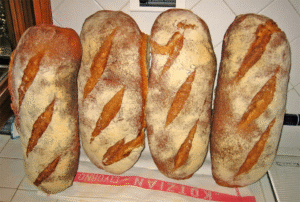Tuscan Bread PDO (Pane Toscano DOP)
Foods, Culinary bases, Flour-based foods, Bread and related doughs
Original name: Pane Toscano DOP
Other names: Pane toscano/Pane sciocco
Nationality: Italy 🇮🇹
Consumption area(s): Tuscany

Introduction
Tuscan Bread PDO is a true excellence of the Italian baking tradition, distinguished by its typical absence of salt and by a production method that follows strict artisan rules. Its origins go back centuries in Tuscany, where it has long been prepared with local flours, natural sourdough starter, and a meticulous crafting process handed down from generation to generation.
Description of Tuscany Bread PDO
This bread, easily recognized by its crisp crust and soft, airy crumb, embodies the deep connection between culture, land, and regional gastronomy. Its most distinctive trait is its simplicity, which enhances both its authentic flavor and its remarkable versatility in the kitchen. The absence of salt not only makes it unique within the Italian bread tradition but also makes it the perfect match for classic Tuscan dishes, from aged cured meats to rustic soups.
Thanks to natural fermentation, Tuscan Bread PDO develops intense aromas and a texture that keeps it fresh and fragrant longer than ordinary breads. Its crust is thin yet crunchy, with a matte dark hazelnut-brown color, while the crumb is white to ivory-white, marked by irregular air pockets. The aroma recalls toasted hazelnuts, and the flavor has a pleasantly tangy note.
Tuscan Bread PDO is produced in different sizes: the filoncino, a rhomboid-shaped loaf, weighs between 0.45 and 0.55 kg, while the filone, rectangular with rounded corners, ranges from 0.90 to 1.10 kg or from 1.80 to 2.20 kg. The thickness of each loaf varies from 5 to 12 cm. Its preparation follows a strict production protocol, which safeguards its authenticity and ensures that each loaf reflects the history and identity of the region.
The flour must be type “0” soft wheat flour, enriched with wheat germ, and sourced exclusively from varieties grown in Tuscany, ensuring both traceability and quality. It is obtained from a balanced mix of red-kernel soft wheat varieties (such as Centauro, Bilancia, Serio, Verna, Pandas – not more than 80%) and white-kernel varieties (such as Mieti, Mec, Marzotto, Bolero – not more than 50%) cultivated in the region. The grain undergoes aspiration and ventilation to remove light impurities, followed by sifting to eliminate coarser material. Before milling, another cleaning step ensures the removal of foreign bodies.
The kernels are then moistened and left to rest for at least 8 hours. Milling takes place with roller mills to obtain type “0” flour with wheat germ. The temperature must never exceed 40°C. After milling, the flour must be stored for at least 10 days to allow maturation. No additives are permitted. The resulting flour must meet specific parameters: W 160–230, P/L 0.35–0.65, water absorption above 54%, C:D > 6’, and a Falling number > 260.
The sourdough starter used is refreshed regularly, then incorporated into a new batch to trigger fermentation. At each refreshment, a portion of the dough is retained to preserve the mother starter for future baking. To maintain the consistency and the unique identity of Tuscan Bread PDO, bakers must rely on a specific type of sourdough: either the traditional one or a freeze-dried version, which is added to type “0” flour (as described above) and water. The microbiological composition of the starter—crucial for production—is safeguarded and monitored by the Consortium for Protection, which guarantees its quality through specialized laboratories at the Faculty of Agriculture of the University of Pisa or affiliated institutions.
History of Tuscany Bread PDO
The tradition of Tuscan Bread dates back several centuries, with written records as early as the 16th century, when Pierandrea Mattioli described the production of “sciocco” bread. In the 18th century, Saverio Manetti documented the Tuscan custom of not using salt, mentioning the “formento”, a natural sourdough starter preserved in the bread chest along with the flour.
During the 19th century, unsalted bread became a staple of the diet of Tuscan tenant farmers. The high cost of salt, primarily used for preserving pork, encouraged the spread of this distinctive baking tradition, which became an integral part of the region’s culinary culture.
In the 20th century, Tuscan Bread continued to be celebrated for its unique qualities. Writers such as Giuseppe Negri highlighted it as an essential element of local cuisine, praising its crisp crust and dense crumb. Today, the PDO regulation protects the traditional recipe, reinforcing the importance of Tuscan Bread as a culinary heritage.
Recipe

Tuscan Bread PDO
Іngredients
- 670 g type “0” flour that meets the specifications outlined
above (5 1/2 cups and 1 tbsp) (for home reproduction, any type “0” flour can be used) - 365 ml
Water (1 1/ 2 cups) - 15 g sourdough starter with microbial composition preserved at the Faculty of Agriculture, University of Pisa (1 tbsp) (for home reproduction, any sourdough starter can be used)
Іnstructions
- Start by preparing the biga. Mix the sourdough starter with 70 g (1/2 cup and 1 tbsp) of flour and 35 ml (2 tbsp and 1 tsp) of water (by hand or using a stand mixer) and let it rest for 8 hours.
- After this time, knead the biga with an additional 600 g (5 cups) of flour and 330 ml (1 cup and 6 tbsp) of water until you obtain a dough with the desired consistency, then let it rest for 20 minutes.
- According to the regulations, the dough would normally be divided into portions with a further 15-minute rest, but in this context, we skip this step since the recipe is for a single loaf. This step is mandatory if the quantities are doubled.
- Shape the rested dough into the typical loaf form and use a very sharp blade to make oblique parallel cuts on the surface. Let it rest again for at least 2.5 hours while preheating the oven to 220°C (428°F).
- Bake the bread for 20 minutes in a fan-assisted oven at the indicated temperature. Then, lower the temperature to 200°C (392°F) and bake for an additional 25–30 minutes.
- Serve the bread at room temperature or reheat the slices before serving.
Notes:
Nutritional facts table
| Nutrients | Total | Per serving (1/10) |
| Calories (kcal) | 2455 | 245.5 |
| Total fat (g) | 6.8 | 0.7 |
| ———Saturated fat (g) | 1.3 | 0.1 |
| Cholesterol (mg) | 0 | 0 |
| Sodium (mg) | 14.1 | 1.4 |
| Total carbohydrates (g) | 512.2 | 51.2 |
| ———Dietary fiber (g) | 20.2 | 2 |
| ———Total sugar (g) | 2.1 | 0.2 |
| Protein (g) | 67.7 | 6.7 |
Recipes that use this product as an ingredient:
Photo(s):
1. fugzu from Pistoia, Italia, CC BY 2.0 https://creativecommons.org/licenses/by/2.0, via Wikimedia Commons

